Psion Series 5
Verdict:
A useful upgrade for the S3c, but missing essential features to compete against Windows CE.
Price:
435 for 4 Mb, 499 for 8 Mb.
Supplier:
Psion 0990 143050
Specs:
Handheld pocket computer, Word, Sheet, Data, Agenda, Time, Calc, Sketch, Spell, Program, Comms, Record. PsiWimn PC connection software and serial cable. Voice recorder buttons and light, IrDA, microphone, speaker, Compact Flash slot. 134 x 50 mm, 640 x 240 pixel touch screen and stylus.
Dimensions:
172 x 89 x 24 mm, 350g with 2 x AA batteries.
Psion's Series 5
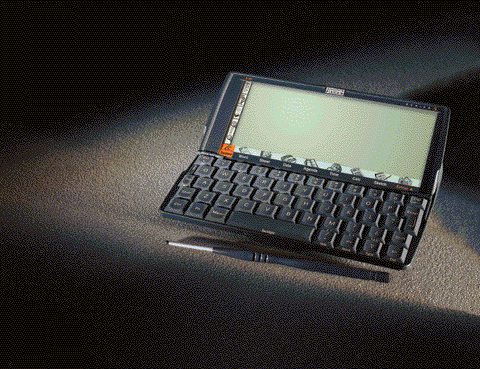
The Series 5 case is only slightly larger than the Series 3, and a similar size to most Windows CE systems. It pivots open into a stable position that won't rock back and forth as you use the supplied stylus on the touch screen. The case appears to be much sturdier than the Series 3, with a secure battery cover and tougher case hinges. The serial interface is the same as the S3c and Siena connector, although the IrDA comms won't talk to the older models.
The processor for the Series 5 is a ARM 7100 model supplied by Cirrus Logic, running at 18.432 MHz. It runs about 4.5 times faster than a Series 3c. Battery life is claimed to be about 35 hours, slightly down on the Series 3c, although it will be a lot less if the backlight is used extensively. The screen includes a row of fixed, touch sensitive icons at the bottom, including one labelled Extras, which opens up to show less commonly used applications, and any user installed ones. An extra set of fixed icons make a column at the left edge of the screen, with icons to open the Menus, the clipboard menu, infrared transfer menu, and to control zooming. The system can be configured to power on when the case is opened (and off when it is closed), or when an icon is touched, as well as operated from the On/Off buttons on the keyboard.
First usable PDA keyboard
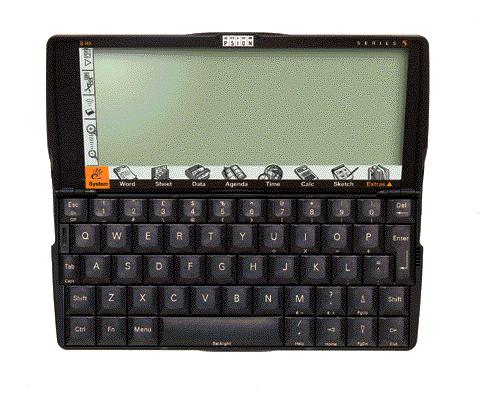
The best feature of the Series 5 is the keyboard. It uses typewriter style keys in a compact layout that is adequate for touch typing and entry of extensive text (like this review). The keys can be used with the thumbs while the unit is held in both hands, as with the older Psion models. Other keys on the back of the case can be used to operate a voice memo recorder with a capacity of about 12 minutes on the 4 Mb model, controlling both record and playback.
Replacing the old Psion proprietary SSD memory modules, there is a single Compact Flash slot, supporting up to 10 Mb cards. Files saved to Compact Flash can be read directly on laptops in a PCMCIA slot, or on a Windows CE palmtop. File formats are, however, not compatible.
The Series 5 uses the EPOC/32 operating system from Psion, which Psion are planning to license to other hardware manufacturers in the future. The current Series 5 hardware appears to conform to the hardware specification for Windows CE, which might make it easier for other palmtop manufacturers to adopt EPOC/32 (or vice versa?).
The familiar apps from the S3c are all there, part from Jotter, with some changes. The only new app is the Bombs game. However, some features have gone missing: the Month view in Agenda, Outline in Word and Program, and rtf export from Word have all vanished. Support for faxing, email and web browsing are all promised as later additions, to be made available as free downloads.
Most apps now support a form of object linking, using any of Sketch, Sheet graphics or Record as sources. Included objects can be edited in the original application, although they are not autoupdated as the source document changes. This can be used, for example, to include pictures taken on a desktop system into the Data application, or graphs from the spreadsheet into a report in Word.
The general look and feel of the user interface has changed, with a more modern impression. Users of older Psion models will feel comfortable with it, as the general layout is much the same. Menus have been reorganised to be more consistent between applications, and screen layouts to make effective use of the touch screen.
New System display

The System display has changed considerably. File names can be of any length and mixed case, and extensions are not required to associate files with applications. The display can be zoomed to anyone of three preset size setting for icon and text display. Files are moved between folder and disks by the Edit menu operations: Cut, Copy and Paste. As with the Series 3c, it is possible to open multiple documents within a single application, and swap between them by pressing the application icon. Pressing the title box of any application will open a list of all running applications and open documents.
A new Control Panel has been built in to the System application to set preferences such as owner information, power options, sound level, time and date, etc.
Word
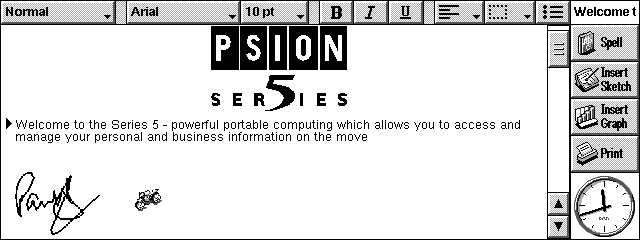
Word now shows fonts as you use them, otherwise is similar to the Series 3c version. As with all other applications, menus have been reorganised from the Series 3c, with additions for object support, but are little changed. The missing Outline view is a big loss, as is the export to rtf capability.
Sheet now has extra features for creating charts, including the old pseudo 3D style for bars.
Data

Data is also little changed from the Series 3c, although the ability to include graphic objects transforms the potential of the application as a cataloguing tool. As a generic database utility this possibly has the most to offer versus otherwise relatively similar Windows CE pocket computers.
Agenda
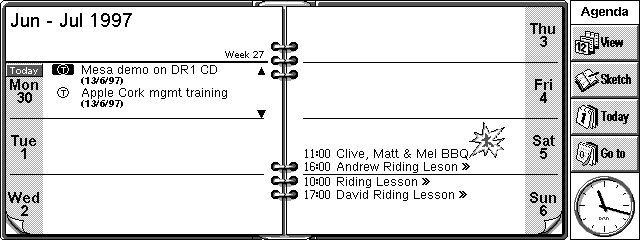
Agenda is missing the very useful month view that was added to the Series 3c. One interesting new feature is that the external light will now flash when an alarm goes off; this allows the use of silent alarms in meetings, for example. The to do list can include objects from Sketch, so you can associate little airplane icons with a flight, telephone icons with a phone call, and so on.
The Record application has probably changed the most, being now competitive with electronic voice memo recorders, allowing you to record multiple notes on a single file, and with high quality compression. The external buttons can be used to record and playback from a file called Voice notes in the Documents folder.
Bombs is a Mines style game. You have to use two presses with the stylus to clear a square, with a slight pause between the presses, which slows down the game considerably. Otherwise it works very much like its big brother on desktop machines.
Sketch is a drawing program, which can be used for freehand sketching with the style (for signatures, for example), or using the library of clipboard images. These include some small road layout images, which can be used to create small maps for giving directions.
The change of processor to an ARM means that old applications from the Series 3 will no longer run. However, OPL has had only relatively minor changes, so shareware authors (many of whom use OPL rather than C) should be able to port their applications to take advantage of the extra facilities of the Series 5 relatively quickly. A simple rebuild on the Series 5 will mean that applications will immediately take advantage of the new look user interface with no other changes to the code. A test using some simple, typical user written OPL programs that I took off a Series 3a revealed that most (but not all) ran immediately, with no changes.
In a big change from their past, Psion now ship the Windows 95 version of PsiWin with the Series 5, as well as a serial cable. Older versions of PsiWin (and other communications programs) should still work, but are unsupported. This includes a wizard to convert files from Series 3 models, but not the other way. You can synchronise the Agenda with Microsoft Schedule+ or Lotus Organizer, which covers to do lists and appointments. However, there is no way to synchronise address books with any product. Command line utilities are provided to convert recordings and images.
PsiWin installs a communications controller in the Start Up folder. This will scan all serial ports (and the infrared port) for an attached Psion unless you fix the port in Properties. This can interfere with other attached devices, such as modems.
Control Backups and Synchronise from Explorer

Browsing the Series 5 from Explorer
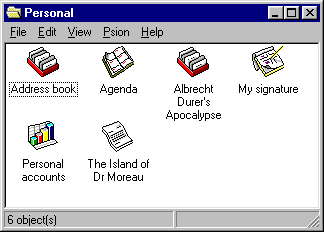
My Psion appears as a desktop icon in Windows 95, and shows in the Explorer, with options to Synchronise, Backup, or browse any installed disks (internal RAM or a Compact Flash card). Dragging files from or to the Explorer window will invoke an automatic format converter. This supports Microsoft Office, Lotus SmartSuite and Corel Office formats. In theory you can also use rtf and comma separated values (csv) for Word and Data respectively, but I had some problems with CSV when trying to move my address book over.
The Series 5 has better hardware than any current Windows CE model, and where comparable applications are available, better functionality in the application. However, despite the better pricing, the lack of email and web browsing may make it unacceptable for many target users. As a replacement for older Psion models it can't be beaten. If you only want the basic applications (addresses, diary, notes and PC communications), the PalmPilot is a more compact and cheaper package that is worth a look.
1,584
Words and design by:
Paul Lynch
Last updated: July 30, 1997